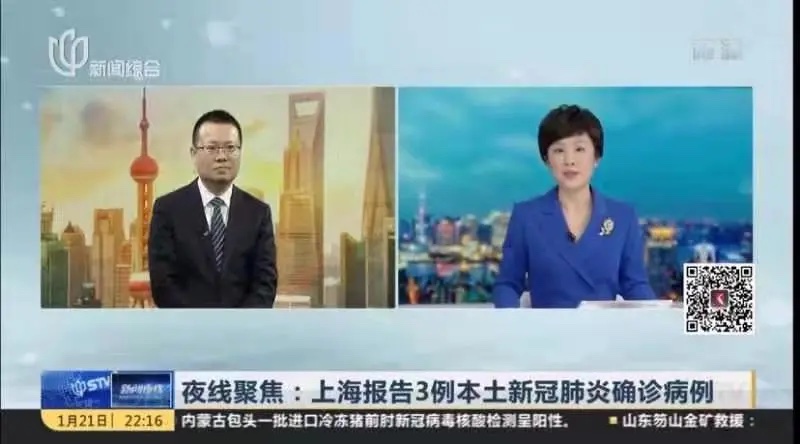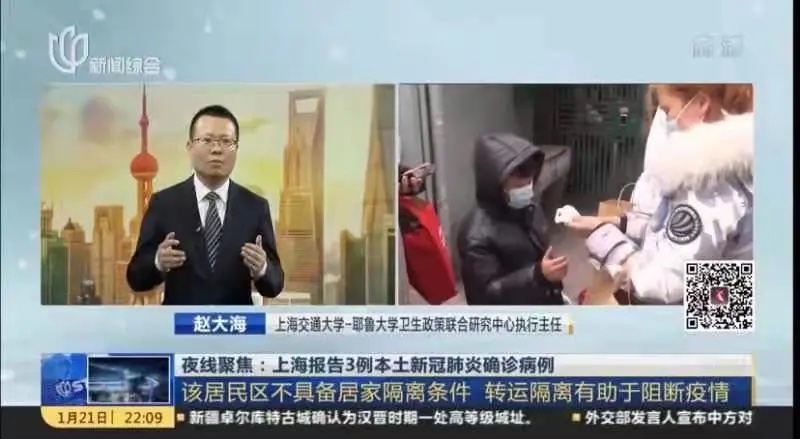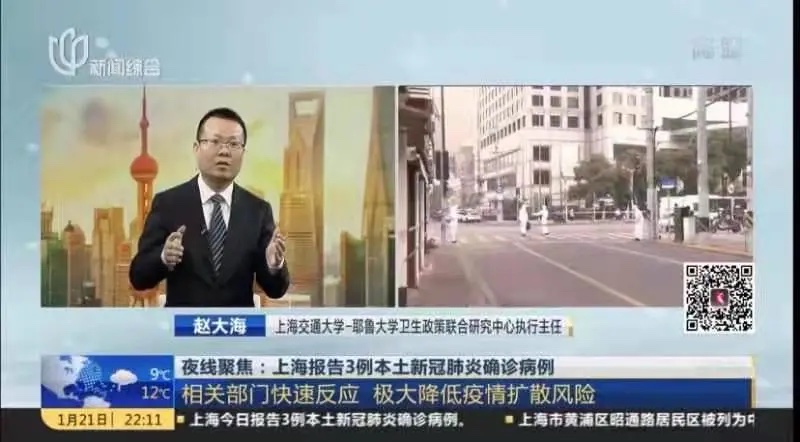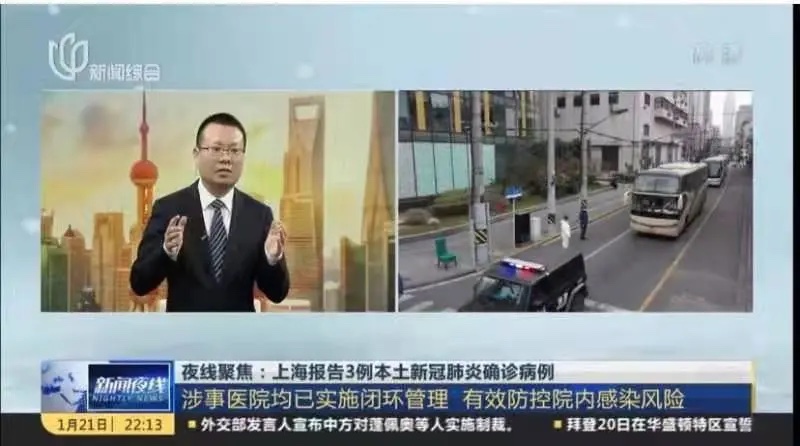上海交大赵大海做客上海电视台:上海新冠疫情防控精准到位

上海交通大学-耶鲁大学卫生政策联合研究中心执行主任、上海交通大学国际与公共事务学院博士生导师赵大海,自新冠肺炎疫情暴发以来,对于新冠疫情暴发、防控以及卫生政策第29次接受上海电视台专访,也是第79次接受央视、上视专访。2021年1月21日,赵大海做客上海电视台新闻综合频道,在《新闻夜线》节目就上海新增本土新冠病例的相关话题进行了直播访谈。现将访谈内容摘录如下。

主持人:这次上海出现新冠疫情之后,我们注意到,防控部门并没有对居民区采取封闭的措施,而是将居民转运集中隔离,这样做是出于什么样的考虑?现在请上海交通大学-耶鲁大学卫生政策联合研究中心执行主任赵大海予以解读。
赵大海:主要是考虑到涉事的居民小区的特殊构造。这个特殊构造不便于我们进行疫情的管控,特别是很难做到老百姓的居家隔离。因此,我们才采取了转运至宾馆等集中隔离点进行疫情管控。

主持人:我们常规的理解,出现疫情以后是把小区直接封闭,现在我们要转运,其实就多了一个转运的环节,这个多出来的这个环节会不会增加疫情传播的风险?
赵大海:理论上讲,只要有转运,有人群的聚集,比如说多个居民共同乘坐一辆转运车等,在理论上,可能会增加疫情管控的难度。但是,在现在涉事的小区,相关部门已经做到了各方面的非常严格的管控措施,比如说对于同一辆公共交通有最大的限制人数,最多不能超过30人,已经尽可能的做到了这一点。相比较于现在小区里边居家隔离,转运对于疫情扩散的风险是极大的降低了。

主持人:我们发现这次的确诊病例,他所居住的小区是一个老式里弄,其实这是一个新的情况啊,老式里弄就是人员密集,居住环境比较落后,那么这样的一个情况会不会增加疫情传播的风险?
赵大海:如果不采取转运的话,在目前的这个小区里边确实会比较容易导致新冠病毒的进一步的扩散和传播,但是我们现在已经考虑到了这一点,已经采取转运的措施。也就是说,我们现在的转运措施已经极大地降低了疫情进一步扩散的风险,规避了现在这个问题。
主持人:刚才跟我们记者在连线的时候,我还注意到了一个信息,他说是涉及到的,需要转运的居民有800多户、2000多居民,为什么还有一部分居民不需要转运?
赵大海:现在我们能做的受到一些客观条件的制约,比如说我们需要对于隔离点的安排。现在一天或者在非常短的时间之内,我们比较难以全部安排掉。现在的超过2000名居民,我们只能是分批的,一步一步的来进行隔离,但最终我们希望这个小区所有的居民,都到集中的隔离点来进行非常严格的、符合常规的管控。
主持人:这次新增的病例,其实还涉及到了他们的工作场所,是在两家医院,大家也很担心会不会引发院内的感染,对这个问题您怎么看?
赵大海:您这个担心应该是有道理的。我们现在已经对这两家医院采取了闭环的管理。从今天早上开始,两家医院已经停诊,所有的入院患者,我们核酸检测之后,如有必要会分批地转到合适的地方。对于现在的管控措施还包括,对于两所医院所有医务人员,包括后勤的工作人员,全部进行核酸检测,全部要一一的排查。在现在的这个非常严格的管控,包括核酸检测的基础之上,我们有理由相信,至少不会让院内感染扩散到社会上,也尽可能防止院内的感染。
主持人:对院内核酸检测的排查,大约需要多长时间?
赵大海:我们应该会在两天左右的时间之内就能完成这两家医院所有医务人员和工作人员的核酸检测。另外,根据现在新的上海市有关部门的要求,上海所有的医疗机构的医务人员也要进行全员的核酸检测,不只是这两家医院。
主持人:那么这两家医院现在已经是门诊停诊了,如果核酸检测结果都出来之后,他们是不是就可以重新开放?
赵大海:如果所有的医务人员以及后勤的行政人员,最理想的状况,核酸检测都是阴性的话,那可能我们还会采取第二轮的核酸检测,如果第二轮依然是阴性的话,那我们会很快就会开放正常的门诊。
主持人:今天下午的这个发布会上,通报说对三例确诊病例的密切接触者,还有相关场所的物品、环境也都进行了采样检测,在已经出核酸检测结果的这些密接者的结果来看,他们都是阴性的,这是个好消息,但是物品环境样本当中发现了四件阳性,都和第一例病例有关,这个结果说明了什么?
赵大海:应该讲,现在的结果没有太出乎我们的意料,因为在原先的其他病例的核酸检测的过程当中,患者所接触过的物品被检出阳性的这个事件是经常发生的。这对于我们整个疫情防控而言,我们不能只针对于患者本身,需要对于患者所起居生活整个空间,包括接触的物品,进行严格的系统的消毒、杀菌的措施,才能保证到彻底的疫情防控。
主持人:这也说明人、物品,环境同检,对于查找漏洞、排查风险是非常重要的,那么现在这个流调工作正在进行当中,在今天下午的这个疫情防控新闻发布会上,也说到了,流调工作要缜密精准,如何做到缜密精准?我们用什么样的方式,通过哪些因素来确定密接人员?
赵大海:对于确定密接人员,以及追溯所有的患者的密切接触者,我们在过去的一年跟新冠病毒斗争的过程当中,已经有了非常成熟的经验,我们主要应用的是大数据的方式,来尽快锁定每一个患者的所有密切接触者。对于所有的密切接触者进行集中的、统一的隔离,这个方式方法,现在应该讲是非常成熟。
主持人:这个大家还是应该放心的,有高科技的保驾护航,现在上海出现了本土病例,广大市民都非常关注这个事儿,接下来上海的市民朋友,我们具体该怎么做?要注意哪些问题?
赵大海:对于上海的居民而言,我们现在需要做的主要有以下几点。在春节假期来临之前,包括整个的春节的假期,尽可能的不要离沪,尽可能的待在家里;第二,进一步在思想上不能松懈,包括像以往一样,外出的时候要佩戴口罩,居家的时候勤洗手,家庭勤通风等。只要我们采取严格的自我防控措施,我们相信上海的整个春节的前后不会发生比较大的新冠疫情的暴发。
供稿者:上海交通大学
日期:2021年1月22日
Dahai ZHAO’s Exclusive Interview with ShanghaiTV: The prevention and control of the epidemic in Shanghai has been precise and effective
Dahai Zhao, a doctoral supervisor at the School of International and Public Affairs of Shanghai Jiao Tong University and Executive Director of Shanghai Jiao Tong University-Yale University Joint Research Center for Health Policy, has been interviewed by ShanghaiTV for the 29nd time (the 79nd time by CGTN / ShanghaiTV) since the COVID-19 pandemic. On January 21, 2021, Zhao commented on the new locally acquired cases of COVID-19 in Shanghai on “News Night-line” of ShanghaiTV.
Anchor: After the new locally acquired cases of COVID-19 in Shanghai, we noticed that the prevention and control authorities did not close down residential areas, but transported residents to be isolated. What kind of consideration did they have in mind? Now let's turn to Zhao Dahai, executive director of SJTU-YALE Joint Center for Health Policy.
ZHAO: The main consideration is the special structure of the community involved. This special structure is not convenient for us to control the epidemic, especially it is difficult to do home quarantine. Therefore, we have taken the transfer to the hotel and other centralized isolation points to control the epidemic.
Anchor: Our conventional understanding, after the outbreak of the community is directly closed. Now we need to transport, in fact, there is an additional link in the transport, this additional link will increase the risk of the spread of the epidemic?
ZHAO: There may be reason to worry. We have now adopted a closed-loop management of the two hospitals. Two hospitals have been closed since this morning. All of the hospitalized patients, after our nucleic acid testing, will be transferred in batches to the right place if necessary. The current control measures also include nucleic acid testing for all medical staff in the two hospitals, including logistics staff, and all the cases should be screened one by one. On the basis of this very strict control, including nucleic acid testing, we have reason to believe that, at least, hospital-acquired infection will not be allowed to spread to the community, and hospital-acquired infection will be prevented as much as possible.
Anchor: How long will it take for the screening of nucleic acid testing in the hospital?
ZHAO: We should be able to complete nucleic acid tests for all medical personnel and staff in the two hospitals in about two days. In addition, according to the new requirements of Shanghai authorities, all medical staff in Shanghai's medical institutions, not just these two hospitals, should also undergo nucleic acid testing.
Anchor: So these two hospitals have now closed their outpatient clinics. Will they be able to reopen once the results of the nucleic acid tests are in?
ZHAO: Ideally, if all the medical staff and logistical and administrative staff are tested negative, then maybe we'll do a second round of testing. And if the second round is still negative, then we'll open the normal clinic very soon.
Anchor: At the press conference this afternoon, it said that close contacts of the three confirmed cases, as well as items and environments at relevant sites, had also been tested. Nucleic acid test results of these contacts have been negative. That's good news. But four of the environmental samples were found to be positive, which all related to the first case. What does this mean?
ZHAO: It should be said that the results so far have not surprised us too much. Because in the course of nucleic acid testing in previous cases, the objects that the patient had come into contact with often tested positive. For our entire epidemic prevention and control, we can not only focus on patients themselves, we need to carry out strict and systematic disinfection and sterilization measures for the whole living space of patients, including the items they contact, in order to ensure thorough epidemic prevention and control.
Anchor: This also shows that the detection of people, goods and environment together is very important for finding loopholes and screening risks. The epidemiological investigation is now under way. This afternoon's press conference on epidemic prevention and control said that epidemiological investigations need to be rigorous and precise. How can they be rigorous and precise? In what way and what factors do we use to determine close contacts?
ZHAO: We've had a lot of experience with COVID-19 over the past year in identifying close contacts and tracing all of the close contacts. We mainly use big data to target all the close contacts of each patient as quickly as possible. The method of centralized and unified isolation of all close contacts is now well established.
Anchor: This we should rest assured with the protection of high technology. Now Shanghai has new locally acquired cases, the general public are very concerned about this. Next, what should Shanghai citizen do specifically? What should we pay attention to?
ZHAO: For the residents of Shanghai, what we need to do now is mainly as follows. Before the Spring Festival holiday, including the whole Spring Festival holiday, do not leave Shanghai as much as possible, stay at home as much as possible. Second, we should not relax our thinking further. Wear a mask when you go out as usual, wash your hands frequently at home, ventilate frequently at home, etc. As long as we take strict self-prevention and control measures, we believe that there will not be a relatively large outbreak of new crown disease around the whole Spring Festival in Shanghai.
Contributor: SIPA, SJTU
Data: January 22, 2021

